How to create excellent observational drawings - 11 tips
Final Updated on November 24, 2021
Observational drawing is an integral component of many high school Art courses, including GCSE/IGCSE and A Level Art. Often, drawing is the core method of researching, investigating, developing and communicating ideas. While it is accepted that there are many wondrous types of drawings – and that not-representational drawing methods have an important office in student Fine art projects – information technology is ordinarily advantageous to demonstrate competent, realistic observational drawing skills to the examiner (especially in the early stage of a projection).
What follows is a list of tips that accept been written specifically for high schoolhouse art students who are looking to meliorate the realism of their observational drawings. Information technology is for those who have already selected something appropriate to draw (encounter this guide for selecting subject thing if you demand aid with this) and who sympathise how to etch a drawing well (this will be covered in a subsequent article).

Tip one: Look at what yous are drawing

Failing to look at what you are drawing is i of the almost fundamental errors an Art student can make
This sounds obvious, but information technology is the about common mistake made by fine art students. Many students endeavour to draw things the fashion that they call back they should look, rather than the way they actually practise look.
The simply manner to record shape, proportion and detail accurately is to look at the source of information. Human memory does not suffice. Forms, shadows and details are hard enough to replicate when they are right there in front of yous; if you take to make them up, they appear even less convincing. In society to produce an outstanding observational drawing, y'all must observe: your eyes must continually dance from the piece of newspaper to the object and back again. Non just one time or twice, but constantly.
Note: even if you pursue a theme about mythical creatures, fairy tales or some other imaginary form, y'all should work every bit much as possible from observation. Slice your creatures together from fragments of life. Apparel people upwardly and then depict them or merge different parts of insects or creatures together (using artistic license every bit advisable) rather than creating an unabridged grade or scene from your caput.
Tip 2: Draw from existent objects whenever possible

The phrase 'observational drawing' typically implies drawing from life (run into the superb observational drawing exercise ready by artist and instructor Julie Douglas). Ask whatever art instructor and they will list the benefits of drawing from objects that are sitting directly in front of y'all. You lot are provided with a wealth of visual information…irresolute calorie-free conditions; rich textures; views of the discipline from alternate angles; as well every bit information from other sense…smells and noise from the surroundings etc. Transcribing from three-dimensions to ii is ultimately much harder than drawing from a photograph, only it ofttimes results in drawings that are 'richer' and more authentic.
(This doesn't mean, however, that you should never draw from photographs. Students frequently traipse from home to schoolhouse and back again: it tin can be impractical to carry and fix up complex still life arrangements over and over over again. Some subjects – such as landscapes and nude models – are likewise unavailable in about classroom settings. Information technology tin therefore be expert practise to ready a even so life arrangement in the flesh (or visit a location) and begin drawing direct from the bailiwick, using photographs to complete the work at home).
Tip 3: Don't trace
Throughout history, great realist painters accept traced from photographs or worked from projections diddled upwardly onto walls. But these painters are not high schoolhouse art students; nor are they assessed on their ability to replicate form.
There is a place for tracing in IGCSE or A Level Fine art (such as when tracing over something yous take already drawn or creating a repeat pattern), but tracing from photographs and then simply applying colour or tone is not acceptable. Such methods of 'drawing' involve minimal skill, teach you niggling and run the take a chance of producing clunky, soul-less outlines. Don't do it.
Tip 4: Understand perspective
As objects become further away they appear smaller. The replication of this change of calibration on paper (through the employ of vanishing points) is called 'perspective'. The fundamentals of perspective are usually taught in inferior high school; by Year 10 at the latest. If you are a senior art student and have somehow missed this lesson, remedy this situation urgently. There are not many theoretical aspects of fine art that are essential to larn, but this is one of them. Please view the perspective handouts in the Student Art Guide free teacher resources to go yous started.
Tip 5. Use grids, guidelines or rough forms to go the proportions correct before you add details
Many students get-go with a tiny particular (the middle on a face, for example) and and then gradually add in the rest of the epitome…ending up with a drawing that is badly proportioned or doesn't fit on the page (or floats aimlessly in the middle of it). This tin can be avoided by approximating the basic forms before adding details or by using guidelines to ensure that proportions are correct.
If working from a photograph, using a grid tin effect in highly accurate piece of work. It allows students to focus on one small segment of the epitome at a time and gives arbitrary lines from which distances can be gauged. This can be a helpful strategy when precise, detailed images are required and can itself go a celebrated component in an artwork. As gridding is methodical and involves meticulous plotting of lines, however, it is important to acknowledge that this approach runs the risk of producing tight and regimented drawings that lack in 'spirit' and should thus exist approached with intendance.
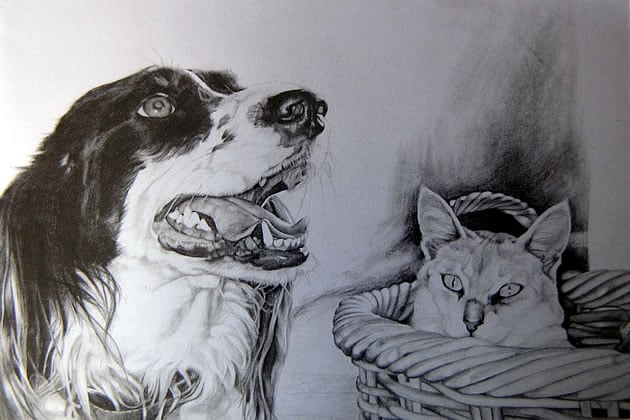
If working from life, roughly sketching outlines of the major forms will allow you to become the proportions right, before you add the details. While you do this, you should constantly check which points line up (i.e. edge of nostrils lining up with edge of eye) and the size of every object should be estimated in relation to the things that are beside it. You must get used to seeing things non in terms of accented scale, just in terms of how ane thing compares to some other.
An initial observational drawing by artist Douglas Flynt:
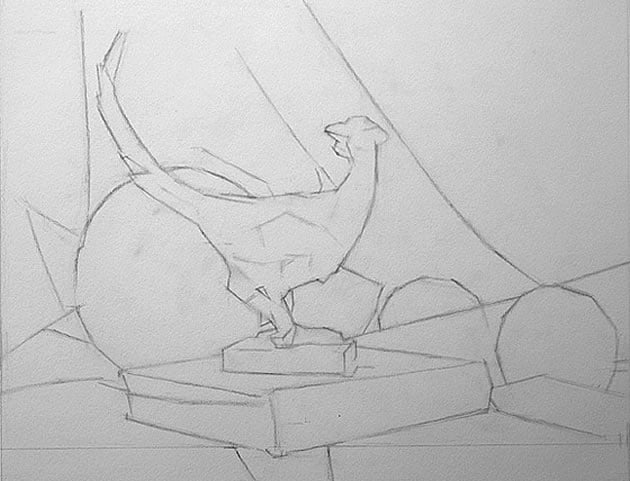
Tip 6: Exist wary of ellipses
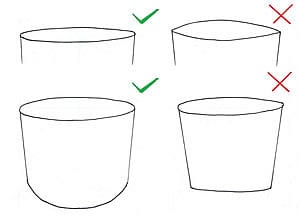
Ellipses – the oval shapes that are visible at the height of cylindrical objects such equally bottles or jars – frequently 'trip up' a weak drawer . They tin send an immediate betoken that a pupil isnot looking at what they are drawing. All ellipses, no matter what angle they are viewed from, should be rounded (not pointed) at the ends, as illustrated in the image to the left (byRachel Shirley) and beneath (sourced from IDsketching).

Tip 7: Keep the outlines low-cal

Equally your drawing is fleshed out in more than item, with attention given to the subtle variations in shape and form, the natural inclination – peculiarly of the novice drawer – is to want to darken in the outlines, to help ensure they are visible. Practice non do this.
Real objects do non take dark lines running effectually every border. Edges should instead exist defined past a change in tone and/or colour, as in the cute graphite drawing by an IGCSE Art educatee shown to the left.
If yous are producing a line drawing, a cartoon or some other graphic image, outlines may be darkened, merely in an observational drawing – especially one which you lot wish to be realistic – dark outlines are never advised.
Tip 8: Have a Skilful Range of Tone
When it comes to applying tone to your cartoon, every bit with everything else, wait at the object. Observe where the light and dark areas are and copy what you encounter. In almost all cases, your drawing should have a full range of tone, from blackness, through a multitude of greys (or coloured mid-tones) through to white.
Some students – having learnt how to blend tone smoothly from dark to light – develop the unfortunate addiction of randomly shading all surfaces from dark to light. Tone should never exist invented and it should never be applied past guesswork.
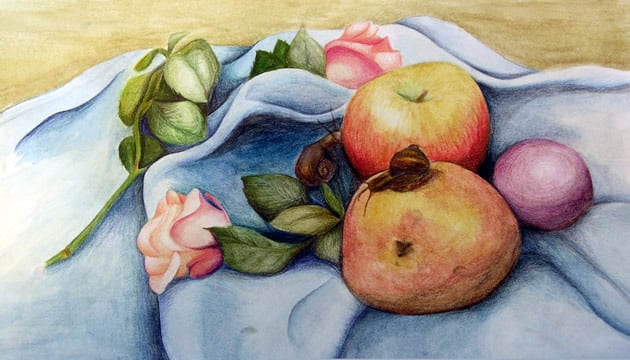
Tip 9: Use marker-making to convey surface quality and texture
When producing an observational cartoon, the marker-making used should help to convey the texture(s) of the subject matter. There are a multitude of dissimilar ways a pencil tin strike paper – hatching / dashes / smudges / dots… think carefully before you determine which technique to utilise.
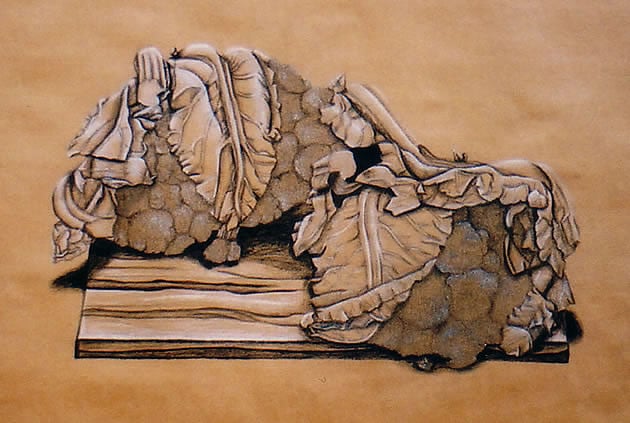
Tip 10: Include / omit detail as necessary
One expanse where students often go disheartened is in the depiction of incredibly circuitous subjects. When drawing trees, plants and bushes, it is not necessary to replicate every leaf or stick. When cartoon a person, it is not necessary to depict every strand of hair. The creative person is always in a position to selection and choose what goes in their artwork. Equally long every bit the conclusion is based on what is aesthetically all-time for the piece of work (rather than wanting to leave out something that is hard to draw…which is frequently the driving force behind students wanting to eliminate certain aspects of their image) there is nothing incorrect with omitting certain details from a cartoon. In fact, oft the limerick is less chaotic and easy on the eye because of it.
There are many approaches to this. Sometimes every unmarried detail might be recorded with accuracy. Sometimes a certain area of a drawing is rendered in full, with other parts trailing away.

Tip xi: Insert your own soul
Most of the tips above are aimed at helping a student create more than realistic observational drawings. This terminal tip is something different. It is a reminder that sometimes information technology is the difference between the real item and the drawing that matters.
Although observational drawings are usually expected to exist realistic in nature, they practise not need to be hyper-realistic (in other words, they don't have to look exactly like a photograph). Often, information technology is the unrealistic parts: the unexpected marker-making – the gap between the existent object and what is fatigued – where the soul sneaks in. Information technology is the beauty in smudges and irregularities and artistic interpretation. Fifty-fifty an IGCSE or A Level Fine art educatee is an creative person. Comprehend this!
A cute graphite drawing by Apr Coppini:

If you enjoyed this commodity, you may also like read the Student Art Guide serial almost artistic use of media, which provides tips and advice for students who are wishing to brand their drawings, paintings or sketchbook presentation more exciting.

Amiria has been an Fine art & Design instructor and a Curriculum Co-ordinator for seven years, responsible for the course pattern and cess of student work in two high-achieving Auckland schools. She has a Available of Architectural Studies, Available of Architecture (First Grade Honours) and a Graduate Diploma of Educational activity. Amiria is a CIE Accredited Fine art & Design Coursework Assessor.
Source: https://www.studentartguide.com/articles/realistic-observational-drawings
0 Response to "How to create excellent observational drawings - 11 tips"
Post a Comment